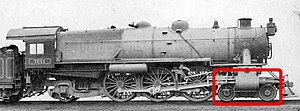Leading wheel

Theleading wheelorleading axleorpilot wheelof asteam locomotiveis an unpoweredwheeloraxlelocated in front of the driving wheels. The axle or axles of the leading wheels are normally located on a leadingtruck.Leading wheels are used to help the locomotive negotiate curves and to support the front portion of the boiler.
Overview
[edit]Many leading bogies do not have simple rotational motion about a vertical pivot.
Bogies with a sliding motion controlled by springs was patented byWilliam Adamsin 1865.[1]Other designs used swing links to take the weight of the bogie with a centering action. The first use of leading wheels is commonly attributed toJohn B. Jervis,who employed them in his 1832 design for a locomotive with four leading wheels and twodriving wheels(a type that became known as theJervis). In theWhytesystem of describinglocomotive wheel arrangements,his locomotive would be classified as a4-2-0,that is to say, it had four leading wheels, twodriving wheels,and notrailing wheels.In theUIC classificationsystem, which counts axles rather than wheels and uses letters to denote powered axles, theJerviswould be classified 2A.
Locomotives without leading trucks are generally regarded as unsuitable for high speed use. The BritishRailway Inspectoratecondemned the practice in 1895, following an accident involving two0-4-4satDoublebois,Cornwall, on theGreat Western Railway.[2]Other designers, however, persisted with the practice and the famous0-4-2Gladstone classpassenger expresses of theLondon, Brighton and South Coast Railwayremained in trouble-free service until 1933.[3]A single leading axle (known as apony truck) increases stability somewhat, while a four-wheel leading truck is almost essential for high-speed operation.
The highest number of leading wheels on a single locomotive is six, as seen on the6-2-0Cramptontype and thePennsylvania Railroad's6-4-4-6S1duplex locomotiveand6-8-6S2steam turbine. Six-wheel leading trucks were not very popular. The Cramptons were built in the 1840s, but it was not until 1939 that the PRR used one on the S1.
See also
[edit]- AAR wheel arrangement
- Adams axle
- Trailing wheel
- UIC classification of locomotive axle arrangements
- Whyte notation
References
[edit]- ^Simmons, Jack; Biddle, Gordon (1997).The Oxford Companion to British Railway History.Oxford: Oxford University Press.ISBN0-19-211697-5.
- ^Rolt, Lionel(1955).Red for Danger.London:Bodley Head.ISBN0-7153-7292-0.
- ^Gladstoneat the National Railway Museum, YorkArchived2006-10-15 at theWayback MachineAccessed 22 December 2006.
